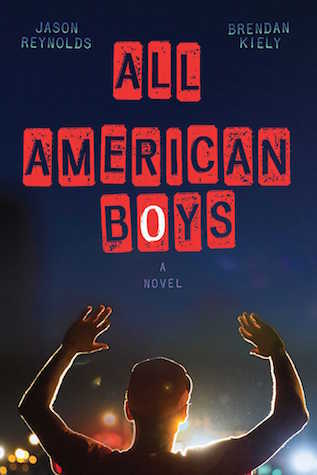 Quinn is a white teenaged boy who plays on the school's competitive basketball team. Rashad is a black teenaged boy who is a junior ROTC cadet, and whose best friends play on the same basketball team as Quinn. Chapters alternate between first-person narratives by Quinn and Rashad, and - unlike some other books that use this same storytelling method - the voices of the boys are distinct enough so you could probably figure out who is narrating without having to read the chapter title, thanks to Rashad's chapters being written by Jason Reynolds (a black author), and Quinn's chapters being written by Brendan Kiely (a white author).
Quinn is a white teenaged boy who plays on the school's competitive basketball team. Rashad is a black teenaged boy who is a junior ROTC cadet, and whose best friends play on the same basketball team as Quinn. Chapters alternate between first-person narratives by Quinn and Rashad, and - unlike some other books that use this same storytelling method - the voices of the boys are distinct enough so you could probably figure out who is narrating without having to read the chapter title, thanks to Rashad's chapters being written by Jason Reynolds (a black author), and Quinn's chapters being written by Brendan Kiely (a white author).
One Friday night, as both boys have the same plans to go to a classmate's party, Rashad is racially profiled inside a corner store and becomes a victim of police brutality perpetrated by a white officer. Quinn witnesses the beating and, to his horror, recognizes the officer as his best friend's older brother Paul, a man who, in many ways, was a surrogate father figure to him after his own father died in Afghanistan. The book starts just before the incident, and spans the following week.
Having read this book on the heels of The Hate U Give, it's easy to compare the two and find similarities, though each does offer something different. The Hate U Give is written entirely from the perspective of a black girl who is the sole witness to a fatal shooting. She watches as her friend's name becomes a hashtag, and struggles as public attention turns to her as the only person who can testify about the shooting. All American Boys, on the other hand, offers the perspective of a black boy who survives a non-fatal attack and sees his own name become a hashtag. It also provides the viewpoint of a white boy who grapples with trying to make sense of what he saw, what it means about the world around him and who he is as a person. Since the incident was caught on video by other bystanders, his testimony probably isn't important to the investigation, but he still needs to make some hard choices to come to terms with what happened.
Rashad's story is compelling, and I imagine it would be especially so if you aren't already a supporter of Black Lives Matter. If you are, I expect you'll find your commitment to the movement reaffirmed, as I did.
For myself, I found Quinn's story to be more eye-opening and thought-provoking. I have to admit, as a liberal person of color who lives in a blue state, I frequently wonder, with no small amount of frustration, why more white people aren't more woke. Why can't they see the racism!? Or if they admit to seeing it, why won't they speak up and fight against it? This book doesn't make excuses for white people, but it does show how it can be difficult for individual white people to take a stand when it means losing life-long friends, challenging long-held beliefs, and actually risking opportunities for a better future (e.g., Quinn taking a stand could affect his place on the basketball team, which would affect his chances of earning a college scholarship). The stakes can be high. Given Quinn's previous relationship with Paul, we see how painful Quinn's position is; how is it that someone who he knew to be so generous and so good to him could actually be capable of such a frightening and unthinkable act? Through Quinn's struggle, we see how for many people, life would be so much easier if they just refuted the evidence and ignored the racism.
As might be expected in a book rated for teens, the boys' authentic teenaged dialogue does include swearing.


No comments:
Post a Comment